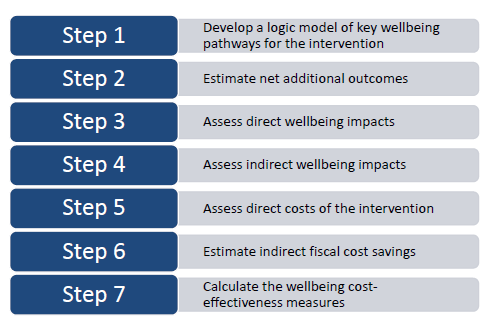Plugging the gaps: new cost-effectiveness guidance for charities
It’s not always easy to put a pounds and pence figure on everything a charity does nor does it always feel like the morally ’right thing’ to do. But, measuring wellbeing effects gives an increasingly valuable alternative route for charities assessing their impact. It speaks to what really drives charitable efforts: not just delivering value for money for funders but improving people’s lives.
Yet gaps in data or a lack of alignment to standardised measures often make the task an uphill battle. How, then, can we?
Pro Bono Economics and the What Works Centre for Wellbeing today publish a seven-step guide to estimate wellbeing cost effectiveness with less-than-perfect information.

Direct and indirect measures
We can, of course, look at direct measures. Self-assessments of life satisfaction may allow us to estimate direct wellbeing benefits. But we can also look more widely at how other outcomes indirectly impact on wellbeing. For example, a charity focused on getting veterans into jobs can look at how the additional employment achieved for these individuals impact wellbeing – as well as the knock-on effects of higher income; lower levels of crime; better physical and mental health; and benefits family members feel.
Focusing on these indirect links to wellbeing comes with greater health warnings than a focus on direct effects. Doing so requires identifying and evaluating evidence from across the literature to find appropriate matches.
We have to consider:
- the age of the evidence
- the variation inherent within such studies
- how the evidence applies to the subject of our research – as looking at how employment relates to the wellbeing of the population in general may not be appropriate for our veterans, for instance.
These necessary checkpoints mean that we may not be able to draw straight lines between all the indirect effects a charity has on individuals and measurable wellbeing impacts, leading to underestimates, but they are essential for accuracy.
Cost-effectiveness
Once we’ve assessed all the impacts and drawn all the connections that we can, we need to take into account costs – including overheads like rent and opportunity costs like volunteer time. Then we need to look at indirect fiscal savings. If a percentage of our veterans are now employed, what taxes are they contributing? How much is the government saving on welfare payments?
When we have both sides of the cost-benefit seesaw assembled, we can run the equation to churn out a much fuller picture than produced by a standard cost benefit analysis.
With this method, we have an exciting opportunity to support holistic yet analytically rigorous wellbeing analysis for charities who haven’t yet gathered data directly measuring their wellbeing impact – giving us a powerful new approach for looking at the impacts of different charitable interventions in a consistent way that more closely reflects the real-world impacts on people’s lives.
This simple best practice guide on evaluating wellbeing impact is now available, alongside the complete worked example for the calculations undertaken for the charity Walking with the Wounded here.
If you’re a charity that’s interested in developing a wellbeing cost-effectiveness study then please get in touch with Pro Bono Economics at info@probonoeconomics.com
More on cost effectiveness
How cost effective is a workplace wellbeing activity?
